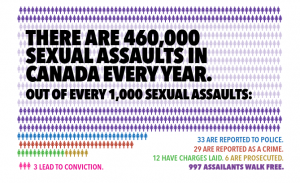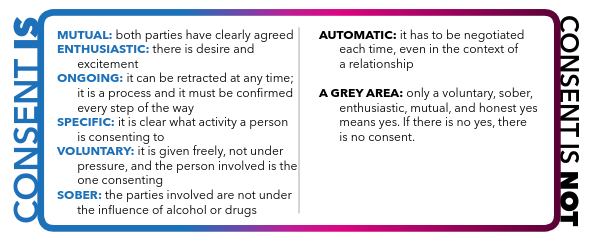Each year, in Canada, approx imately 460,000 women are sexually assaulted, although only a fraction of them report the assault to the police (1). In a day and age where this statistic holds true, it’s hard to imagine that our government is wanting to go back to a time where consent and gender identity aren’t being discussed in classrooms as a part of the Health Curriculum. Simply ignoring the very real issues that our students face in 2018 doesn’t make them go away, nor does it help to develop a society that is action-based and ready to implement change.
imately 460,000 women are sexually assaulted, although only a fraction of them report the assault to the police (1). In a day and age where this statistic holds true, it’s hard to imagine that our government is wanting to go back to a time where consent and gender identity aren’t being discussed in classrooms as a part of the Health Curriculum. Simply ignoring the very real issues that our students face in 2018 doesn’t make them go away, nor does it help to develop a society that is action-based and ready to implement change.
Earlier this year I was really excited to hear about ETFO’s and White Ribbon’s resource – Drawing The Line. Now I might be slightly biased as my brother is a contributing author but I was thrilled to see a resource that not only provided data-driven information for educators but also included a comprehensive guide for age-appropriate lessons for students in grades 1 to 8. I love that the guide addresses bystanders and offers students ways in which to respond to to sexual violence. Not only do the lessons connect to the Health and Physical Education Curriculum but expectations also in Language and the Arts are included in many of the lessons. This guide is truly a proactive approach to teaching students about healthy relationships and is one that every educator should read and implement in their classrooms. I know that in the past, ETFO was offering sessions on this resource and I hope that they continue.

With hotlines or tiplines being made available, it’s sad to say that we are in such a time where educators are somewhat in fear of teaching what we know to be essential for our students’ safety and healthy development. We need to be having these conversations because unless we do, nothing will change and perpetrators will feel empowered to continue. As you may already know, at the beginning of September, ETFO filed a legal injunction to pause the rollback of the 2015 Health curriculum. The union believes the government’s directive creates unsafe and unhealthy learning and working environments. In the meantime, how are you working to unpack these issues with students? They’re in the news and on the same social media platforms that students are interacting with. How will the work we do today impact the statistics in the future? In the next year, 5 or 10? If you haven’t already, please check out this resource as well as the other resources that ETFO has to offer.
1. Holly, Johnson, “Limits of a Criminal Justice Response” (University of Ottawa, 2012), https://books.openedition.org/uop/592?lang=en
